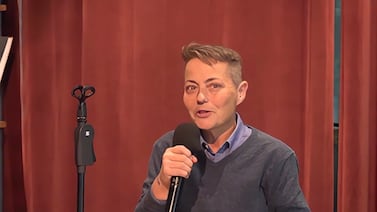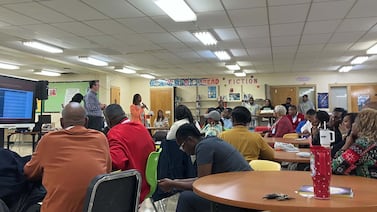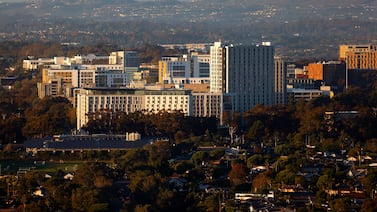Sign up for Chalkbeat New York’s free daily newsletter to get essential news about NYC’s public schools delivered to your inbox.
With nearly 2 million New York City residents soon to lose federal food stamps, schools across the five boroughs are scrambling to create plans to quickly get extra food to hungry families.
Officials in President Donald Trump’s administration have said they will stop funding the Supplemental Nutrition Assistance Program, or SNAP, starting Nov. 1 if the federal government, which has been shut down for nearly a month, doesn’t reopen.
That would cut off benefits for roughly 1.8 million city residents who received $5 billion worth of food assistance in 2025, according to the Independent Budget Office. That count includes about 500,000 children.
It’s not clear exactly how many city students receive SNAP, but more than three-quarters of district and charter school students — roughly 806,000 — qualified for free or reduced-price lunch, or government benefits including SNAP, last year, according to city data.
School leaders say the abrupt loss of food benefits would be devastating and could set off a cascade of other challenges for kids that would show up in the classroom.
“I’m worried it’s going to be a crisis,” said Ben Geballe, principal of M.S. 131 in Chinatown, where nearly 90% of students live in poverty. “If you’re on SNAP, you’re living on the edge already. You give people a little push, and it can be very challenging.”
Schools like Geballe’s are now scrambling to set up their own ad hoc food distribution systems, tapping into their budgets, raising outside funds, and leveraging their relationships with parents and community partners to help ensure families don’t have to rely only on outside food banks that will be facing a crush of new demand.
Geballe’s school is restarting a school food pantry where families who are homeless or otherwise food insecure get a bag of groceries every two weeks. He’s asked a private donor who contributed money to help cover field trips to repurpose those funds for food. And the school is brainstorming ways to get kids involved as helpers, including by allowing them to donate prizes they earn for good behavior to the school’s food bank.
The school partners with a community based organization on an after-school program, and they are working together to expand meal service for those who stay later, so kids can count on three free hot meals — a breakfast before school, lunch, and a hot “supper” around 3:30 p.m.. All students get free breakfast and lunch in city schools.
State leaders pledge to help plug some gaps
State leaders have promised to step in to fill some of the federal funding gap. Gov. Kathy Hochul committed $30 million in state funds earlier this week to cover about 16 million meals at food pantries. State Attorney General Letitia James also joined a multistate lawsuit that seeks to force the U.S. Department of Agriculture, which oversees SNAP, to tap into billions of dollars in emergency reserves to continue funding SNAP.
So far, the city Education Department hasn’t launched any systemwide efforts to get extra food to families losing SNAP benefits.
“We are aware of potential SNAP disruptions that may affect our school community,” said Isla Gething, a department spokesperson, “and our students can continue to count on their school meals.”
Hochul has said she’s exploring the idea of using schools to send home additional food with families but hasn’t released any concrete plans.
In the meantime, city schools are continuing to devise their own food distribution plans.
At M.S. 50 in Williamsburg, Brooklyn, Principal Ben Honoroff said the school has spent years building systems to help families facing food insecurity. It now expects a big uptick in demand.
The school is planning to tap its federal Title I funds for students in temporary housing to give families vouchers they can redeem at local restaurants and subsidize orders on the online grocery site Fresh Direct. Families living in shelters, he noted, don’t have access to kitchens and need meals that don’t require much preparation.
Other schools are turning outwards to collect extra money.
Sally Schwab, an assistant principal at University Prep Charter High School in the South Bronx said roughly 85% of her students’ families receive SNAP. She launched a GoFundMe page Tuesday with the goal of raising $5,000, and had already surpassed that goal by Wednesday morning. The school plans to use the funds to buy grocery store gift cards and stock up on basics that they’ll distribute through a school food pantry.
At the Urban Assembly Institute of Math and Science for Young Women in downtown Brooklyn, administrators sent home a letter to families and staff earlier this week warning about the looming SNAP cuts and asking for donations to the school’s food and clothing pantry.
The school’s principal, Kiri Soares, said she’s trying to stockpile food that fits her families’ cultural backgrounds as well as other supplies like diapers and menstrual products that families use SNAP benefits to purchase.
Several school leaders said that if the SNAP shutdown drags on, they hope the city and state will launch a more comprehensive effort to tap public schools as a way of distributing food. During the COVID pandemic, schools became community food distribution centers, handing out millions of free meals to both students and families and other community members.
“The infrastructure is there,” said Soares. “It would be an easy switch to flip.”
Michael Elsen-Rooney is a reporter for Chalkbeat New York, covering NYC public schools. Contact Michael at melsen-rooney@chalkbeat.org.




